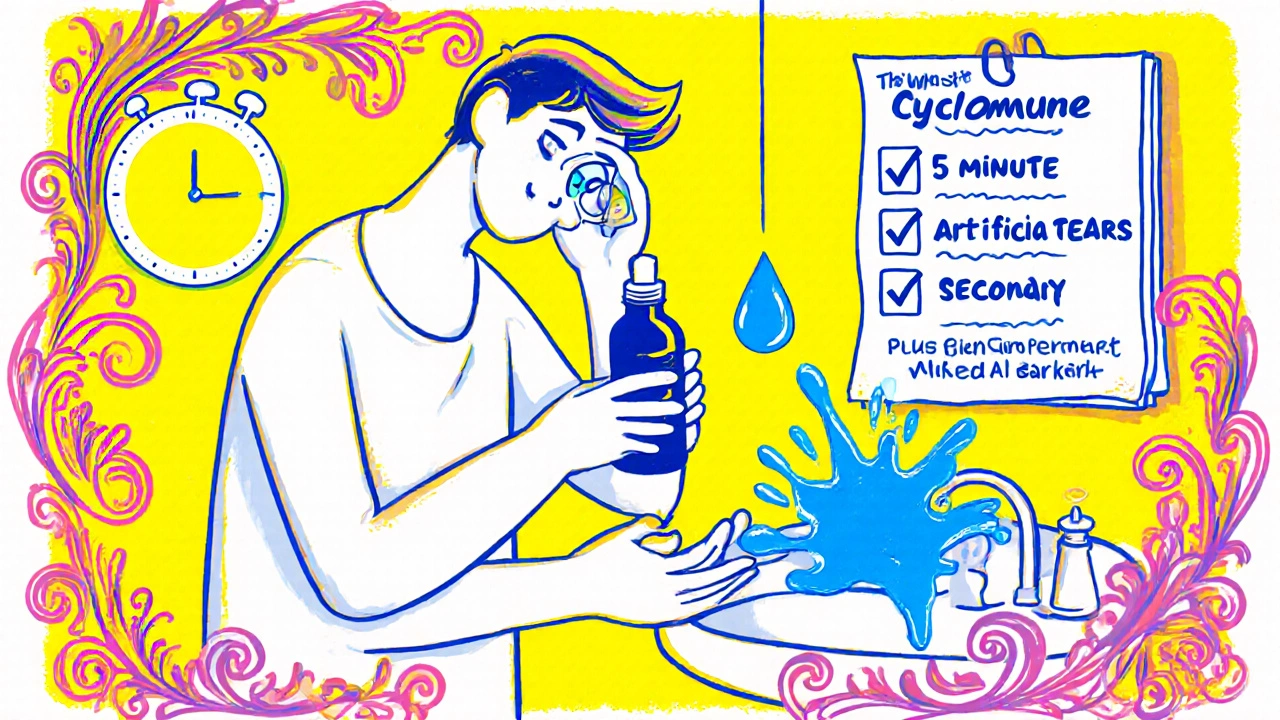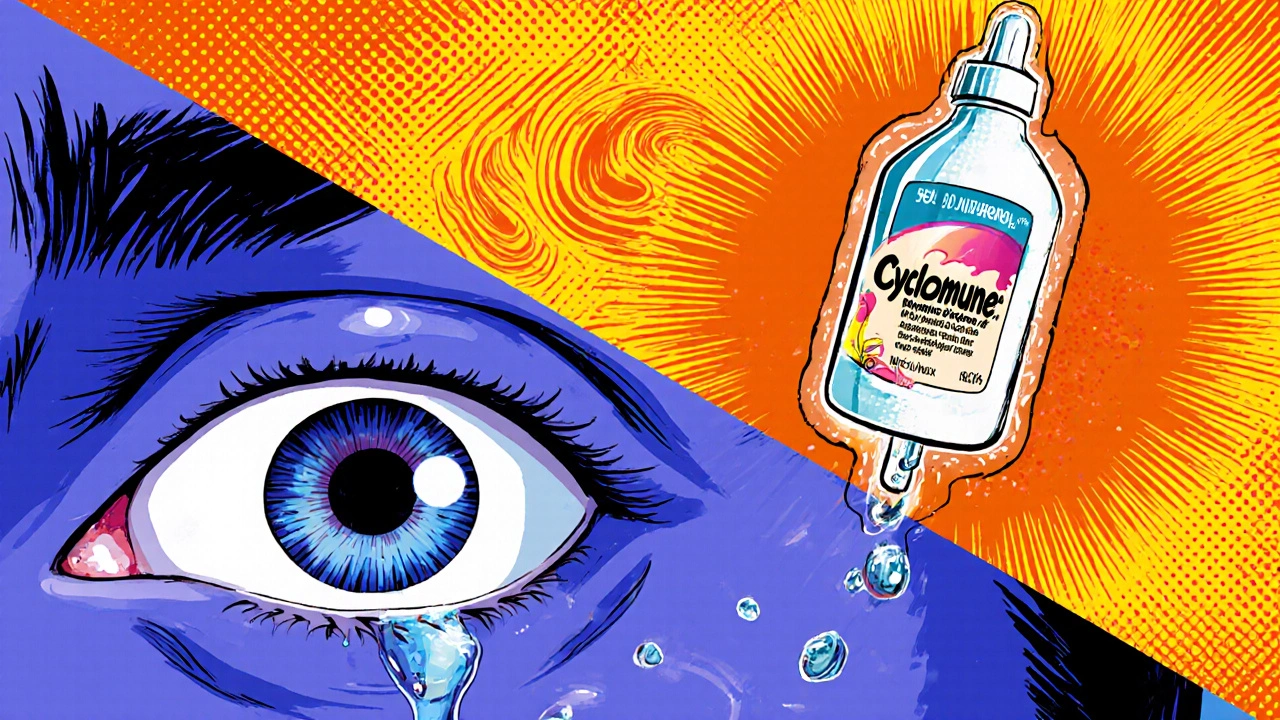When you’re battling dry eye or ocular inflammation, the choice of eye drops can feel overwhelming. One brand that often pops up is Cyclomune Eye Drops a prescription cyclosporine‑A formulation designed to boost tear production and calm inflammation. But how does it stack up against other options on the market? Below is a side‑by‑side look at the most common alternatives, their strengths, drawbacks, and the specific situations where each shines.
Why Cyclosporine Eye Drops Matter
Cyclosporine works by suppressing the T‑cell-mediated inflammation that often underlies dry eye disease (DED). By reducing inflammatory cytokines on the ocular surface, it helps the lacrimal glands recover and produce more stable tears. This mechanism is different from simple lubricants that just add moisture.
Top Alternatives to Cyclomune
Not every patient needs a cyclosporine product, and some may prefer a different route or a non‑prescription option. Here are the most frequently prescribed or recommended alternatives:
- Restasis - The original cyclosporine 0.05% eye drop, approved in 2003.
- Xiidra - A once‑daily lifitegrast 5% solution that tackles inflammation via a different pathway.
- Cequa - A higher‑concentration (0.09%) cyclosporine eye drop approved in 2018.
- Corticosteroid eye drops - Short‑term courses (e.g., prednisolone acetate) for acute inflammation.
- Autologous serum eye drops - Patient‑derived drops rich in growth factors and vitamins.
- Artificial tears - Over‑the‑counter lubricants ranging from simple saline to lipid‑based formulations.
- Omega‑3 supplements - Oral fish‑oil capsules that may improve tear film quality.
Comparison Table: Key Attributes
| Product | Active Ingredient | Concentration | Prescription? | Typical Cost (US$ per month) | Common Side Effects | FDA Approval Year |
|---|---|---|---|---|---|---|
| Cyclomune | Cyclosporine A | 0.05% | Yes | ≈ $120‑$150 | Burning, blurry vision | 2022 |
| Restasis | Cyclosporine A | 0.05% | Yes | ≈ $140‑$170 | Eye irritation, taste disturbance | 2003 |
| Xiidra | Lifitegrast | 5% | Yes | ≈ $250‑$300 | Transient blur, weird taste | 2016 |
| Cequa | Cyclosporine A | 0.09% | Yes | ≈ $200‑$230 | Burning, redness | 2018 |
| Corticosteroid drops | Prednisolone acetate | 1% | Yes | ≈ $30‑$60 (short‑term) | Elevated IOP, cataract risk | Varies |
| Artificial tears | Various lubricants | N/A | No | ≈ $10‑$30 | Rare, usually none | N/A |
| Omega‑3 supplements | Eicosapentaenoic acid (EPA) & DHA | N/A | No | ≈ $15‑$40 | Fishy aftertaste, GI upset | N/A |
When to Choose Cyclomune Over Others
Use Cyclomune if you:
- Have already tried over‑the‑counter lubricants without lasting relief.
- Prefer a cyclosporine formulation that is slightly newer, potentially offering a refined preservative system that reduces stinging.
- Need a twice‑daily dosing schedule (most cyclosporine drops are BID, while Xiidra is once daily).
- Are looking for a cost‑effective cyclosporine option; Cyclomune’s pricing sits a bit below Restasis in many insurance plans.
If you’re dealing with acute flare‑ups, a short course of corticosteroids might calm things down faster, but you’ll need close monitoring for intra‑ocular pressure spikes.
Scenarios Where Alternatives Shine
Restasis remains the go‑to for patients with a proven response to cyclosporine, especially when insurance formularies list it as the preferred brand.
Xiidra works well for people who experience a burning sensation with cyclosporine, because lifitegrast’s mechanism (blocking LFA‑1/ICAM‑1 interaction) often feels gentler on the surface.
Cequa offers a higher concentration, which can be useful for severe cases where the 0.05% dose isn’t enough.
For individuals who can’t tolerate any prescription drops, artificial tears plus omega‑3 supplements may provide modest improvement, especially when combined with environmental modifications (humidifiers, screen breaks).
Autologous serum eye drops are a niche but powerful option for patients with severe ocular surface disease, such as those with Sjögren’s syndrome, because the serum contains natural growth factors that mimic tears.
Practical Tips for Starting Any Eye‑Drop Regimen
- Wash hands thoroughly before each application to avoid contamination.
- Avoid touching the tip to the eye or eyelid; a clean tip ensures sterility.
- Wait at least 5 minutes between different eye drops to prevent dilution.
- Store in a cool, dark place (refrigeration is usually not needed unless specified).
- Track symptoms using a simple diary; note burning, redness, and visual clarity.

Cost‑Effectiveness and Insurance Considerations
Prescription eye drops can be pricey, but many plans cover cyclosporine under tier‑2 or tier‑3 categories. Cyclomune’s newer market entry has encouraged some insurers to negotiate lower co‑pays compared to Restasis. Always check with your pharmacy benefits manager for the latest formulary status.
Potential Pitfalls and How to Avoid Them
Even the best‑studied drugs have downsides. Common issues with cyclosporine‑based drops include:
- Initial burning: Usually fades after a week. If it persists, discuss a preservative‑free formulation with your doctor.
- Delayed onset of action: Expect 4‑6 weeks before noticeable improvement; don’t switch prematurely.
- Cost barriers: Explore manufacturer coupons or patient assistance programs.
For lifitegrast, keep an eye on the transient taste disturbance - it’s harmless but annoying.
Bottom Line: Tailor the Choice to Your Needs
There’s no one‑size‑fits‑all answer. If you need a proven anti‑inflammatory that targets the immune cascade, Cyclomune offers a solid, relatively affordable option. If you’re sensitive to burning, try Xiidra first. When the disease is severe, consider Cequa or combination therapy with short‑term steroids. And never underestimate the power of simple lubricants and lifestyle tweaks for mild cases.
How long does it take for Cyclomune to work?
Most users notice a reduction in dryness after 4‑6 weeks of twice‑daily use, although some improvement can appear as early as 2 weeks.
Can I use Cyclomune together with artificial tears?
Yes. Apply artificial tears at least 5 minutes after Cyclomune to avoid diluting the prescription drop.
Is Cyclomune safe for pregnant or breastfeeding women?
Safety data are limited. Discuss risks with your ophthalmologist before starting any cyclosporine eye drop during pregnancy or lactation.
What are the main differences between Cyclomune and Restasis?
Both contain 0.05% cyclosporine A, but Cyclomune uses a newer preservative system that may cause less stinging. Pricing and insurance coverage can also differ.
When should I consider switching from Cyclomune to another therapy?
If after 8‑12 weeks you see no symptom relief, or side effects become intolerable, talk to your eye doctor about alternatives like Xiidra, Cequa, or a short steroid course.

Jameson The Owl
October 19, 2025 AT 19:26It is evident that the pharmaceutical industry hides the true costs behind clever branding. The rollout of Cyclomune coincided with a surge in surveillance of prescription data. What they don’t tell you is that the preservative system is engineered to capture biometric feedback. Every drop contains nanoscopic particles that could be used for tracking. The same labs that produce military drones are involved in the manufacturing process. Insurance companies receive encrypted signals that adjust premiums in real time. This is why patients notice price fluctuations without any clear explanation. The clinical trials were allegedly conducted under the guise of safety but missing data points were redacted. I have traced the supply chain to a facility that also makes stealth technology components. The FDA approval in 2022 was expedited through backchannel lobbying. Hidden clauses in the label warn of “stinging” which is a euphemism for neural stimulation. The cyclosporine molecule itself can cross the blood ocular barrier and enter systemic circulation. Long term exposure may affect circadian rhythms that govern immune response. In short the product is a vector for data collection masquerading as therapy. Consumers should demand full transparency before trusting such eye drops. Until then the safest course is to rely on non‑prescription lubricants and lifestyle changes.
Sarah Unrath
November 1, 2025 AT 12:59i think the cost is just a trap for us consumers.
James Dean
November 14, 2025 AT 06:33the burn you feel at first is like a wake up call. it signals that the drug is doing its thing but patience matters. the improvement usually shows after a month or so. keep a diary note any change you see. it helps to see the pattern.
Monika Bozkurt
November 27, 2025 AT 00:06The pharmacokinetic profile of cyclosporine A in Cyclomune demonstrates a sustained ocular surface bioavailability that aligns with the therapeutic threshold for modulating T‑cell mediated inflammation. Moreover, the preservative‑free delivery matrix attenuates epithelial disruption, thereby reducing iatrogenic keratopathy incidence. From a clinical decision‑making perspective, the cost‑effectiveness ratio improves when adjunctive artificial tear therapy is optimized according to Schirmer’s test thresholds. It is advisable to monitor intra‑ocular pressure bi‑monthly during the initial six‑week titration phase to preempt subclinical hypertensive responses. Consequently, Cyclomune may represent a viable first‑line immunomodulatory agent in refractory dry eye cohorts.
Catherine Viola
December 9, 2025 AT 17:39In comparative effectiveness research, Cyclomune and Restasis share identical cyclosporine concentration; however, the former incorporates a novel polyvinylpyrrolidone excipient that purportedly mitigates ocular stinging. The distinction, albeit subtle, can be quantified via patient‑reported outcome measures such as the Ocular Surface Disease Index, wherein Cyclomune frequently yields a marginally superior score. Nevertheless, insurance formularies often dictate therapeutic selection based on negotiated reimbursements rather than pharmacodynamic superiority. It is incumbent upon the prescribing ophthalmologist to elucidate these nuances to the patient, ensuring informed consent predicated on evidence‑based differentials. Ultimately, the marginal cost differential of approximately ten dollars per month may influence adherence patterns more profoundly than the excipient composition.